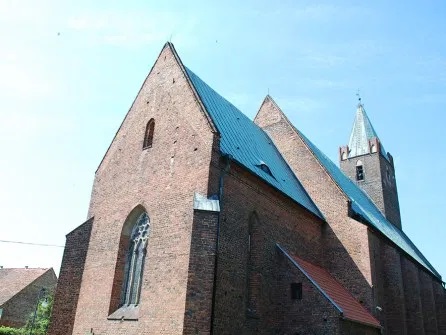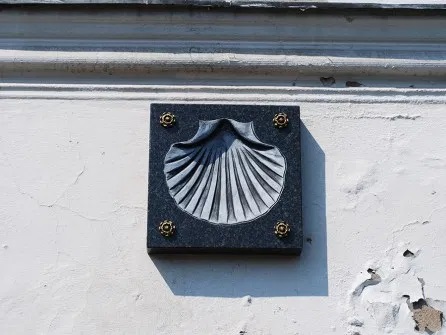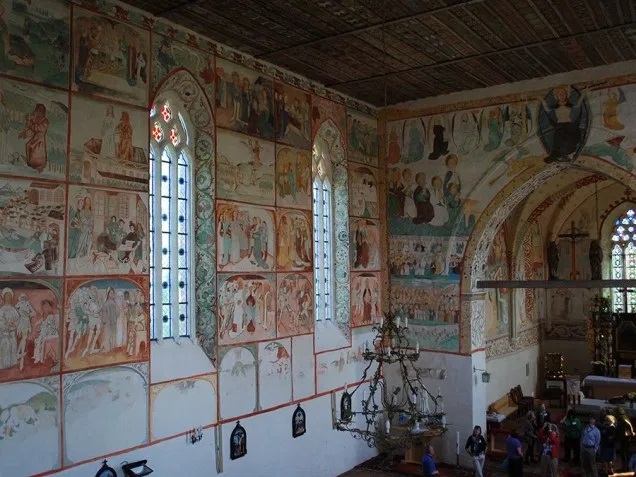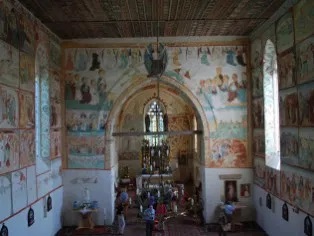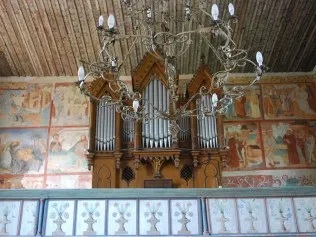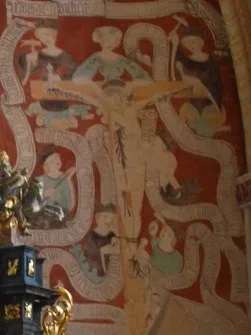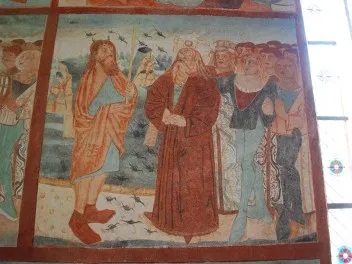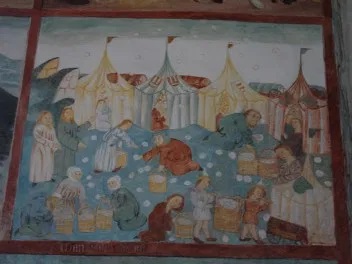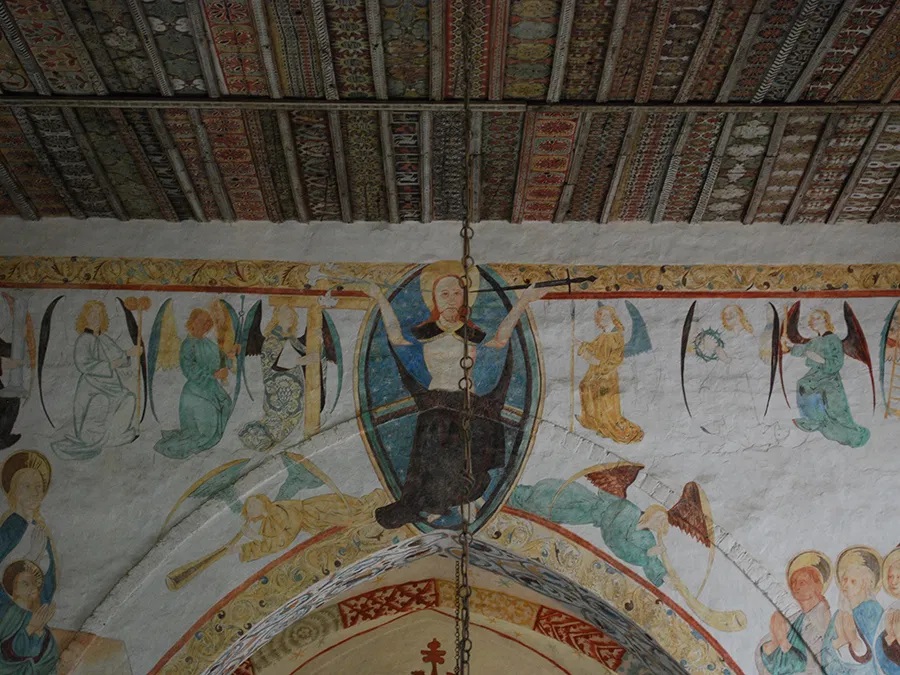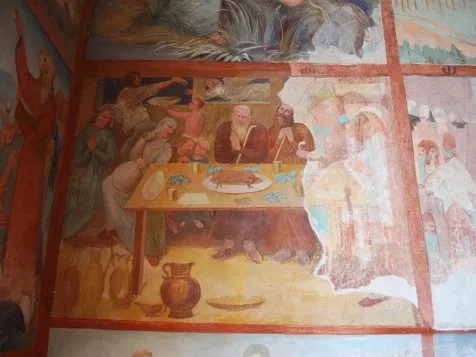The church of Saint Jacob the Apostle: a hidden gem in Małujowice
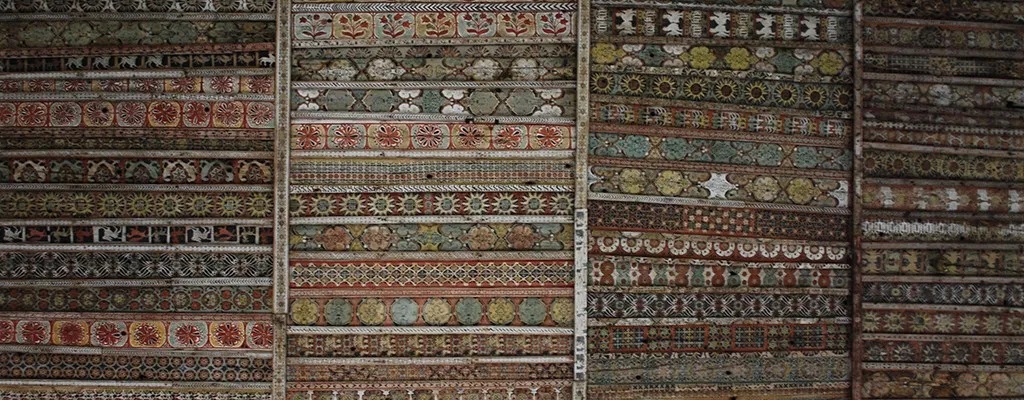
Of the many sites the Trust visited in Poland this past spring, one of the most intriguing and mysterious was the Church of Saint Jacob the Apostle. This wonder of a church is (rather incongruously) situated in the tiny village of Małujowice, just a few short kilometers from Brzeg.
The sleepy size and remote location of the village bely its historic importance. On the political front, it was the location of the Battle of Mollwitz in 1741, the first military victory for King Frederick the Great during the War of Austrian Succession. Although the then-untested monarch made several tactical blunders, his ultimate success put the region of Silesia (now southern Poland), under Prussian and German control until World War I.
On the cultural front, the church of Saint Jacob is one of the best-preserved painted Gothic churches in Europe, and the state of its surviving frescos point to a level of vibrant artistic life normally associated with the great Renaissance courts of Italy rather than rural Central Europe. Near many of the trade routes through the region, the church of Saint Jacob also had the distinction of being associated with one of the many pilgrimage routes through Europe to the shrine of Saint James in Santiago de Compostela—a route in Poland that went long dormant during the conflicts of the 20th century and has only recently been revived.
The church itself dates from before 1315, when it was first mentioned in official records, of having been built at the behest of a local knight, Sambora of Kazanów. Like many small churches, its overall form is simple: merely a rectangular nave, a chancel on the eastern end, and a bell tower opposite. It is the artistic embellishment that truly sets the church apart as an icon. The highlight of the church are the frescoes, which historians believe were painted in three successive campaigns, the earliest from 1370-1380, a second campaign from 1450-1460, and the third and final from 1475-1483.
The earliest frescoes, showing the creation of Adam and other scenes of the fall of man, are on the west wall of the nave, and partially obscured by the later addition of the choir and organ loft. These frescoes have seen the worst damage, but are still legible enough to discern the story, which was their most important function. In an age where the majority of the populace was illiterate, and Catholic mass was conducted in Latin rather than the local vernacular, these scenes functioned as the “illiterate man’s bible,” so to speak, serving as visual cues for the stories of Christianity to the populace, as well as reminding them of their moral and civic duties.
These moral messages continue in the chancel, which was decorated during the second campaign roughly eighty year later. The scenes here are more abstract, rather than didactive, and include the Tree of Jesse, a family lineage of Christ from the Old Testament line of David. The east wall of the chancel depicts two unique scenes on either side of the window. On the left is Our Lady of Good Health, a poignant reminder of an age when plagues and pandemics still regularly decimated European populations. On the left is the image of Christ crucified, surrounded by the seven cardinal virtues, all of whom (curiously enough) are engaged in the elements of his death: Mercy and Justice nail his hands to the cross, for instance, while Faith places the crown of thorns on his head, and hope touches the wound in his side. This type of iconography is extremely rare in Christian art, and only occurs twice elsewhere in Poland. This particular conceit remains largely unstudied by art historians, and may stem from a devotional or meditation text.
The vast majority of the nave was decorated in the final campaign between 1475 and 1483. Although the artists for this work remain anonymous, records pinpoint the date of their work. These scenes are strictly didactic, with 36 Old Testament and 60 New Testament scenes, including the Last Judgement in its traditional place on the east wall, surrounding the arch to the chancel. These scenes contain some of the most sophisticated painting and narrative scenes, with many of the birds painted on the underside of the chancel arch being easily identifiable local ornithological specimens.
The wooden ceiling is one of the church’s most spectacular features. The stenciled decoration incorporates both abstract and representational imagery, including fruits, flowers, and vegetation, as well as religious imagery such as the sign of IHS. Although these decorations were applied with stencils, each board in the ceiling is unique.
One of the many reasons these murals survive in such wonderful condition is that they were covered with plaster as a result of the counter-reformation in the sixteenth century. They lay hidden for the better part of three centuries, and were only rediscovered in 1865. Between 1865 and 1870, they were “restored” by Berlin artist Karl L’Ollet de Mars, although much of the original detail was painted over in oils. A second, full-scale conservation effort happened between 2010 and 2012, as a result of growing interest in the church as part of a wider recognition of medieval murals throughout Europe in the late 1990s. Today, lovingly restored, they provide rest and wonder for tourists, worshippers, and pilgrims alike.
About The Decorative Arts Trust Bulletin
Formerly known as the "blog,” the Bulletin features new research and scholarship, travelogues, book reviews, and museum and gallery exhibitions. The Bulletin complements The Magazine of the Decorative Arts Trust, our biannual members publication.








